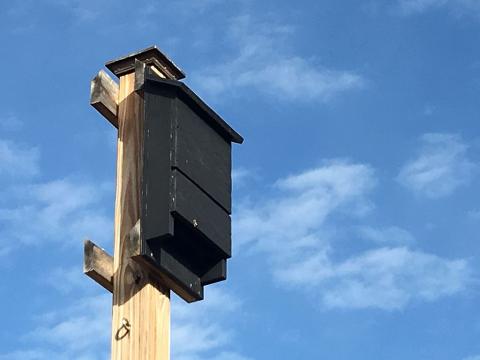I’d like to buy and install a bat house in my backyard. What should I look for, and where should I place it?

Awareness and interest in attracting bats to the yard and garden is no coincidence. Not only are bats fascinating creatures, but they also provide considerable natural pest control. Bats eat enormous quantities of insects (up to 50% of their body weight every night), including agricultural and forest pests as well as mosquitos. Of the eight species of bats in New Hampshire, two of them: little brown and big brown bats, can often be enticed to take up residency around human dwellings. Successfully attracting bats to the backyard requires quality foraging habitat and good roosting sites. With populations of tree cavity roosting bat species like little and big brown bats in decline due to the effects of White Nose Syndrome and habitat loss, properly constructed and placed bat houses can be an important factor in assisting their survival.
Buying a Bat House
Bat houses can be found for sale at a great number of locations, but they’re not all created equally. Many bat houses are poorly designed and constructed and are unlikely to attract many residents. According to Bat Conservation International, effective bat houses are at least 20 inches tall and 14 inches wide, have numerous roosting chambers inside, and a three to six inch landing area at the base. If you have any doubts about which bat house to purchase, consider buying from a BCI certified vendor. If you have some carpentry skills, it’s also fairly straightforward to construct your own bat house.
Placement
Proper placement of the bat house is just as important as good design. Temperature has a huge impact on whether bats will use a bat house or not. Without exception, bat houses should be placed in areas that receive at least eight hours of direct sunlight every day. Bats are far more likely to roost in houses that are very warm and get a lot of sun. In New Hampshire, where the climate is relatively cool, bat houses that are painted black or very dark brown are used more often than ones that are light colored or natural wood, simply because they create a warmer environment.
Bats prefer houses that are mounted on buildings to those mounted on poles or trees. Buildings help increase and moderate the internal temperature of the bat house and also provide some protection from the weather. Bat houses placed in trees are usually less successful due to a few factors; they generally receive less sun, branches make it harder for bats to enter and exit, and predators have easier access.
Once you know where and how you want to mount your bat box, you need to make sure that the house is far enough above the ground or other obstacles such as shrubs. The bottom exit of the bat house should be at least 12 to 20 feet from the ground or tallest vegetation. Bats tend to drop six to eight feet when they leave bat houses and won’t use houses that are lower than 12 feet.
In addition, bats like to do much of their foraging near bodies of water such as ponds, lakes, or streams. Siting the bat house near any of these features will increase its likelihood of being used. Supporting insect diversity in your backyard by encouraging the growth of native vegetation will also improve bat habitat.
Maintenance
Bat houses do require some annual maintenance to keep bats using them year after year. Paper wasps often create nests in the roosting chambers, and bats won’t use any slots with nests present. Make sure to clean out wasp nests in the late winter or early spring before the bats return to your backyard. Bat houses will may also need to be repainted or stained periodically as the color chips or fades over time.
Move-In Period
Sometimes it takes bats a little while to find and start using a new bat house. Young bats don’t disperse to new habitats until late July or early August, so you may find that your bat house doesn’t get many occupants until later in the season. It can sometimes take a year or two for bats to find new bat houses, particularly if there isn’t currently a large population in the area. If after two years your bat house still isn’t getting any use, try moving it to another location.
Got questions? The Ask UNH Extension Infoline offers practical help finding answers for your home, yard, and garden questions. Call toll free at 1-877-398-4769, Monday to Friday, 9 a.m. to 2 p.m., or e-mail us at answers@unh.edu.
Related Resource(s)
Do you love learning about stuff like this?
SUBSCRIBE TO Granite State Gardening newsletter
Got questions? The UNH Extension Yard and Garden Infoline offers practical help finding answers for your yard and garden questions.
Call toll free at 1-877-398-4769, Monday to Friday, 9 a.m. to 2 p.m., or fill out webform.
